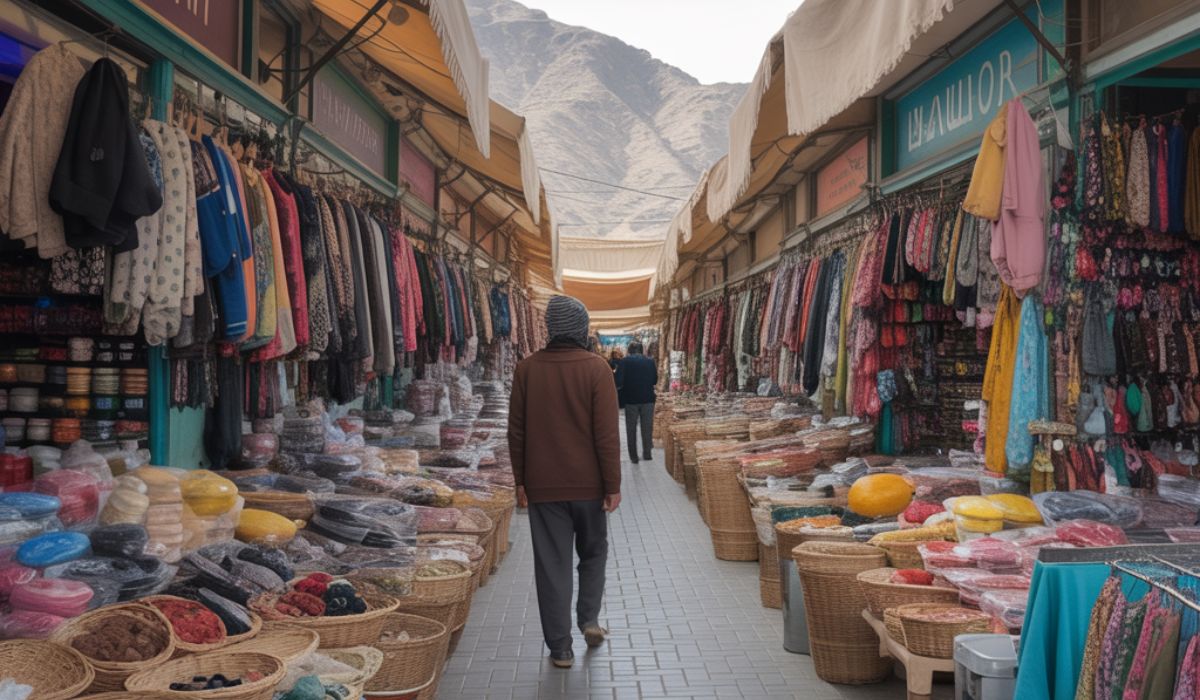Exploring The Markets In Kabul, Afghanistan means experiencing the vibrant heartbeat of the city through its bustling bazaars, traditional stalls, and lively streets. These markets reflect the cultural richness of Afghanistan, where history, tradition, and modern daily life come together in one place.
Exploring The Markets In Kabul, Afghanistan Amid the aroma of freshly cooked street food, the colorful bird market, and the laughter of people bargaining, the atmosphere feels nothing short of magical. The energy, diversity, and warmth of the locals turn each step into a memorable story worth experiencing.
Exploring The Markets In Kabul, Afghanistan offers travelers a chance to witness authentic Afghan life, from sunset bazaars to lively night gatherings. It showcases the resilience, joy, and hospitality of the people, making it one of the most captivating experiences for anyone visiting the city.Exploring The Markets In Kabul, Afghanistan
Historical Context: Trading Crossroads of Central Asia
Kabul’s markets trace their DNA back 2,000 years to the ancient Silk Road. Persian merchants, Indian traders, and Central Asian nomads converged here, creating Afghanistan’s merchant culture that survives today.
The Kabul Bazaar system evolved through empires. Mughal rulers established covered markets. British colonial influence brought structured trading hours. Soviet occupation forced many merchants underground, creating today’s informal networks.
Traditional Afghan merchant culture operates on trust over contracts. A handshake seals deals worth thousands of dollars. Family trading relationships span generations. These customs remain intact despite decades of conflict.
Modern Kabul city life reflects this heritage. Vendors still use brass scales their grandfathers imported from India. Carpet sellers employ techniques perfected in medieval Herat workshops. Change comes slowly to Afghanistan’s commercial districts.
| Historical Period | Market Development | Cultural Impact |
|---|---|---|
| Ancient Silk Road | Initial trading posts | Multicultural merchant class |
| Mughal Era (1500s-1700s) | Covered bazaar construction | Persian architectural influence |
| British Period (1839-1919) | Structured trading hours | Introduction of standardized weights |
| Soviet Era (1979-1989) | Underground informal networks | Cash-based survival economy |
| Post-2001 | Market reconstruction | International NGO involvement |
Chicken Street: The Cultural Shopping Haven
Chicken Street remains Kabul’s most famous shopping destination for good reason. This narrow lane packed with handicraft shops offers Afghanistan’s finest traditional goods in one concentrated area.
What You’ll Discover Here
Authentic Afghan carpets dominate most storefronts. Hand-knotted Herat carpets feature intricate geometric patterns passed down through generations. Prices range from $200 for small prayer rugs to $5,000 for museum-quality pieces.
Lapis lazuli jewelry showcases Afghanistan’s national gemstone. Local artisans craft necklaces, rings, and decorative objects from stones mined in Badakhshan province. Quality varies dramatically—examine pieces carefully before purchasing.
Traditional Afghan clothing includes embroidered vests, pakol hats, and flowing shalwar kameez sets. Women’s clothing features mirror work and gold thread detailing that requires months to complete by hand.
Antiques and historical artifacts fill dusty shop corners. British colonial-era items mix with Soviet memorabilia and pre-Islamic bronze pieces. Verify authenticity and export legality before buying expensive items.
Insider Shopping Strategies

Best visiting hours run from 10 AM to 4 PM when natural light helps evaluate merchandise quality. Many shops close during Friday prayers and remain shuttered on Islamic holidays.
Bargaining etiquette follows specific rules in Afghan culture. Start at 40% of the asking price. Negotiate slowly with respect. Accept tea when offered—refusing appears rude to vendors.
Essential Dari phrases for shopping:
- “Qeemat-e in chande?” (What’s the price of this?)
- “Kam konid” (Reduce the price)
- “Khayli qemat ast” (It’s very expensive)
- “Tashakor” (Thank you)
Safety considerations remain important for foreigners in Kabul. Travel with local guides when possible. Avoid carrying large amounts of cash. Respect photography restrictions—many vendors prefer not being photographed.
Ka Faroshi: The Living Bird Market Experience
Ka Faroshi Bird Market represents one of Kabul’s most authentic cultural experiences. This traditional bird market Kabul operates exactly as it did centuries ago, showcasing Afghanistan’s deep connection to falconry and songbird appreciation.
Afghan households traditionally keep songbirds for their morning melodies. Canaries, nightingales, and local finch varieties fill wooden cages stacked three stories high. Prices start at $10 for common songbirds and reach $300 for rare mountain species.
Falconry equipment occupies specialized stalls. Leather gloves, wooden perches, and traditional hunting bells reflect Afghanistan’s nomadic heritage. Many items are handcrafted by the same families for generations.
Morning visits between 7-9 AM offer the best bird selection and most active atmosphere. Vendors arrive before dawn to feed birds and arrange displays. Evening in Kabul brings fewer options as many birds get sold during peak hours.
Cultural significance runs deeper than mere pet keeping. Bird ownership connects urban Afghans to rural traditions their grandparents practiced. Caring for songbirds teaches children responsibility and patience—values central to Afghan traditions.
Mandawi Bazaar: Authentic Local Commerce
Mandawi Bazaar provides the most genuine local shopping in Kabul experience. This sprawling market serves neighborhood families rather than tourists, offering unfiltered glimpses into daily life in Kabul.
Fresh Produce and Seasonal Specialties
Afghan street vendors arrange pyramid displays of pomegranates, grapes, and melons depending on season. Spring brings fresh herbs like cilantro and mint essential for Afghan cooking. Summer features stone fruits from Kandahar province.
Seasonal variations dramatically affect product availability:
Spring Markets (March-May):
- Fresh green almonds and pistachios
- Wild spinach and mountain herbs
- Early vegetables like radishes and turnips
Summer Selection (June-August):
- Herat melons and Kandahar grapes
- Apricots, peaches, and cherries
- Fresh dairy products from nomadic herders
Fall Harvest (September-November):
- Pomegranates and persimmons
- Dried fruit preparation begins
- Nut harvests from mountain regions
Winter Offerings (December-February):
- Preserved and dried goods dominate
- Imported citrus from Pakistan
- Root vegetables stored from harvest
Household Goods and Daily Necessities

Kabul city life revolves around cash purchases of daily essentials. Mandawi’s household section stocks everything from cooking pots to children’s clothing at prices local families can afford.
Traditional Afghan foods and spice vendors occupy entire market sections. Cardamom pods, saffron threads, and dried mint create aromatic clouds that drift through narrow walkways. Many spices come from family farms in remote provinces.
Payment methods remain strictly cash-based. Afghanistan’s banking system limitations mean even large purchases require physical currency. Money exchange happens informally through trusted vendors who offer better rates than official channels.
Cultural Immersion Opportunities
Afghan hospitality shines brightest in local markets. Vendors invite strangers for tea without expecting purchases. Children practice English phrases with visiting foreigners. These interactions provide authentic cultural exchanges tourism rarely offers.
Photography etiquette requires constant awareness. Many women prefer not being photographed. Always ask permission before photographing vendors or their merchandise. Respect extends to avoiding images during prayer times.
Peak shopping times vary by day and season. Mornings bring freshest produce and most selection. Ramadan in Kabul creates unique evening markets as families prepare for breaking fast in Ramadan celebrations.
| Shopping Category | Best Times | Price Range (USD) | Bargaining Expected |
|---|---|---|---|
| Fresh Produce | 6-10 AM | $0.50-$5 | Minimal |
| Household Goods | 10 AM-3 PM | $2-$50 | Moderate |
| Textiles | 11 AM-4 PM | $5-$200 | Heavy |
| Spices | Any time | $1-$20 | Light |
Food Markets: Culinary Heart of Afghan Culture

Street food Kabul offers Afghanistan’s most accessible cultural experience. These food markets showcase centuries-old recipes adapted to modern urban life.
Traditional Afghan Specialties
Nan bread varieties form the foundation of every Afghan meal. Tandoor ovens built into market stalls produce fresh rounds throughout the day. Nan-e-Afghani features sesame and nigella seeds. Nan-e-roghani incorporates oil for softer texture.
Fresh and dried fruits reflect Afghanistan’s agricultural diversity. Vendors specialize in specific products—one stall focuses entirely on dates from Helmand province, another on pistachios from Badghis region.
Spice vendors operate like neighborhood pharmacies, prescribing specific combinations for health issues. Turmeric for inflammation. Cardamom for digestion. Black cumin for respiratory problems. This traditional knowledge predates modern medicine by millennia.
Street Food Safety and Recommendations
Bustling city atmosphere creates challenges for food safety. Follow these guidelines for safe street food Kabul experiences:
Safe Options:
- Fresh-baked bread from busy stalls
- Whole fruits you peel yourself
- Tea prepared with boiled water
- Grilled meats cooked thoroughly
Foods to Avoid:
- Pre-cut fruit sitting uncovered
- Dairy products without refrigeration
- Tap water and ice
- Seafood (Afghanistan is landlocked)
Popular Street Foods:
- Bolani – Stuffed flatbread with potatoes or greens ($0.50)
- Mantu – Steamed dumplings with meat and yogurt ($2-3)
- Kabuli Pulao – Seasoned rice with lamb and carrots ($3-5)
- Firni – Rice pudding with cardamom and pistachios ($1-2)
Community gathering Ramadan transforms food markets into evening celebrations. Vendors extend hours to serve families shopping for iftar meals. Special Ramadan foods appear only during holy month periods.
Practical Visitor Guide for Market Exploration
Safe travel tips Kabul begin with understanding current security situations. Consult embassy websites for updated guidance before traveling. Register with your embassy upon arrival.
Essential Preparation
Dress code requirements demand conservative clothing regardless of gender. Long sleeves and pants remain mandatory. Women should carry headscarves even if not always required. Modest dress shows respect for Afghan culture.
Currency and Payment:
- US dollars accepted at higher exchange rates
- Afghan Afghanis required for small purchases
- Credit cards not accepted anywhere
- Carry small bills for easier transactions
Best visiting schedule:
- Saturday-Wednesday: Full market operations
- Thursday: Reduced hours, early closures
- Friday: Many shops closed for prayers
- Islamic holidays: Most markets shut down
Transportation and Navigation

Taxi drivers Kabul possess encyclopedic knowledge of market locations and current security conditions. Negotiate fixed rates before starting journeys. Expect $5-10 for cross-city market tours.
Kabul traffic at night becomes particularly challenging. Plan market visits during daylight hours when possible. Evening in Kabul markets operate primarily around mosques and residential areas.
Walking routes between major markets:
- Chicken Street to Mandawi: 15-minute walk
- Ka Faroshi to Mandawi: 10-minute walk
- Mandawi to Shah-e-Do Shamshira: 20-minute walk
Language and Communication
Essential market vocabulary in Dari and Pashto:
| English | Dari | Pashto |
|---|---|---|
| How much? | Qeemat-e in chande? | Daa tso dai? |
| Too expensive | Khayli qemat ast | Der gran dai |
| Good quality | Khob ast | Sha dai |
| Thank you | Tashakor | Manana |
People smiling in Kabul often indicates successful cultural exchange. Afghans appreciate foreigners attempting local language even with basic phrases.
Economic Impact: Supporting Afghan Communities

Kabul tourism experience directly impacts local families through market purchases. Every carpet, jewelry piece, or meal bought supports extended networks of artisans, farmers, and transporters.
Understanding Market Economics
Afghan Bazaars experience operates on thin profit margins. Vendors typically earn 10-20% markup on goods. Large purchases significantly impact family incomes in ways Western tourists rarely comprehend.
Supporting local artisans:
- Buy directly from producers when possible
- Pay fair prices without excessive bargaining
- Commission custom pieces for higher artisan income
- Recommend quality vendors to other travelers
Women’s economic participation remains limited but exists in specific market sectors. Female vendors often sell textiles, jewelry, and food products from home-based workshops.
Market employment data:
| Market Sector | Estimated Vendors | Average Daily Income | Family Members Supported |
|---|---|---|---|
| Handicrafts | 300-400 | $10-25 | 4-6 |
| Food/Spices | 200-300 | $8-20 | 5-7 |
| Textiles | 150-200 | $12-30 | 4-5 |
| Household Goods | 400-500 | $6-15 | 3-5 |
Ethical Shopping Considerations
Market negotiation should balance fair prices with cultural expectations. Paying tourist prices supports families while maintaining bargaining traditions important to Afghan culture.
Export considerations affect antique and handicraft purchases. Verify legal export status for valuable items. Some historical artifacts require government permits for removal from Afghanistan.
Quality verification prevents disappointment and supports honest vendors. Learn to distinguish machine-made from handmade goods. Ask about materials and production methods. Quality vendors welcome educated questions.
Photography and Cultural Sensitivity Ethics

Beautiful evening Kabul provides stunning photography opportunities, but cultural sensitivity must guide every camera decision in Afghanistan’s markets.
Photography Guidelines
Permission protocols:
- Always ask before photographing people
- Respect “no” answers without argument
- Offer to share images with subjects
- Avoid photographing women entirely
Sensitive locations where photography isn’t appropriate:
- Inside mosques during prayer times
- Near security checkpoints
- Women’s market sections
- Money exchange areas
Respectful documentation focuses on handicrafts, architecture, and general market atmosphere rather than individuals. This approach captures Kabul’s cultural essence without compromising anyone’s privacy.
Social Media Responsibility
Sharing images responsibly means considering how photos might affect people pictured. Avoid posts that could endanger vendors or reveal security-sensitive information.
Caption considerations:
- Provide context about Afghanistan’s rich heritage
- Avoid political commentary or oversimplification
- Credit local guides and vendors when possible
Beyond Shopping: Cultural Exchange and Understanding
Exploring Kabul through its markets reveals layers of meaning invisible to casual observers. These aren’t just commercial spaces—they’re cultural preservation centers where traditions survive despite decades of upheaval.
Afghan resilience manifests in merchants who rebuilt stalls after every conflict. Vendors who learned English to serve international visitors. Families who maintained centuries-old craft techniques through wars that destroyed everything else.
Human connections formed over shared tea and broken language barriers often prove more valuable than purchased goods. Foreign restaurant Kabul meals pale compared to impromptu invitations to family compounds where hospitality transcends politics.
Cultural Learning Opportunities
Market interactions teach patience, respect, and appreciation for different ways of conducting business. Western efficiency meets Afghan relationship-building in fascinating cultural exchanges.
Traditional skills observation:
- Watch carpet weavers work on family looms
- Observe metalworkers using techniques unchanged for centuries
- Learn spice combination secrets from multi-generational vendors
- Understand wool processing from mountain sheep to finished products
Language immersion happens naturally through shopping interactions. Basic Dari phrases learned in markets prove useful throughout Afghanistan. Vendors often become informal language teachers for curious visitors.
Supporting Afghanistan’s Future
Sunset activities Afghanistan include market visits that directly support civilian populations struggling with economic uncertainty. Tourism revenue, however modest, provides alternative income sources to more problematic economic activities.
Long-term impact of respectful cultural tourism:
- Preserves traditional crafts through economic viability
- Provides positive international engagement opportunities
- Supports moderate voices in Afghan communities
- Maintains cultural bridges during political isolation
Kabul travel guide recommendations always emphasize visitor responsibility. Every interaction shapes local perceptions of foreigners and influences Afghanistan’s relationship with the broader world.
Markets remain Afghanistan’s most accessible cultural classroom. Here, history lives through merchant traditions. Art survives in handcrafted goods. Hospitality flourishes despite hardship. Community endures through shared commercial spaces.
Your market journey through Kabul offers more than souvenirs—it provides genuine cultural exchange that benefits everyone involved. These vibrant Kabul markets represent Afghanistan’s enduring spirit, proving that commerce, culture, and human connection transcend any temporary political situation.
Sunset Bazaar Kabul activities conclude each market day as vendors pack goods and count earnings. But the relationships formed, traditions observed, and mutual understanding developed continue long after you leave Afghanistan’s remarkable capital city.
conclusion
Exploring The Markets In Kabul, Afghanistan is more than shopping; it is a journey into culture and daily life. The colors, sounds, and flavors make every moment unforgettable. From street food to bird markets, each corner has a story that reflects the spirit of the city.
For any traveler, Exploring The Markets In Kabul, Afghanistan is a must-do experience. It shows the beauty, warmth, and traditions of the Afghan people. Walking through these markets leaves lasting memories and a true picture of the heart of Kabul.Exploring The Markets In Kabul, Afghanistan
FAQs
1. Is it safe to visit the markets in Kabul now?
Travel to Kabul is not considered safe due to risks like terrorism, unrest, and limited medical help.
2. Are there any tourists visiting Kabul’s markets today?
Yes, thousands of foreign tourists have recently visited Afghanistan, with growing interest in Kabul’s markets.
3. Do foreign women face the same restrictions in the markets as Afghan women?
Foreign women often experience more relaxed rules, but wearing modest clothing and a headscarf is still advised.
4. What are the current travel advisories regarding visiting Kabul?
Most countries still issue the highest warnings, strongly advising against travel to Kabul for safety reasons.
5. Can visiting Kabul markets help support local communities?
Yes, buying from vendors in Kabul markets directly supports local families and their livelihoods.








